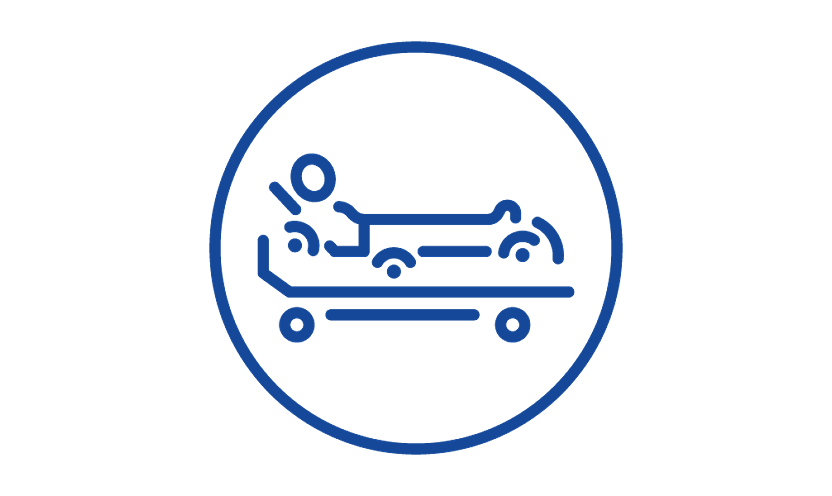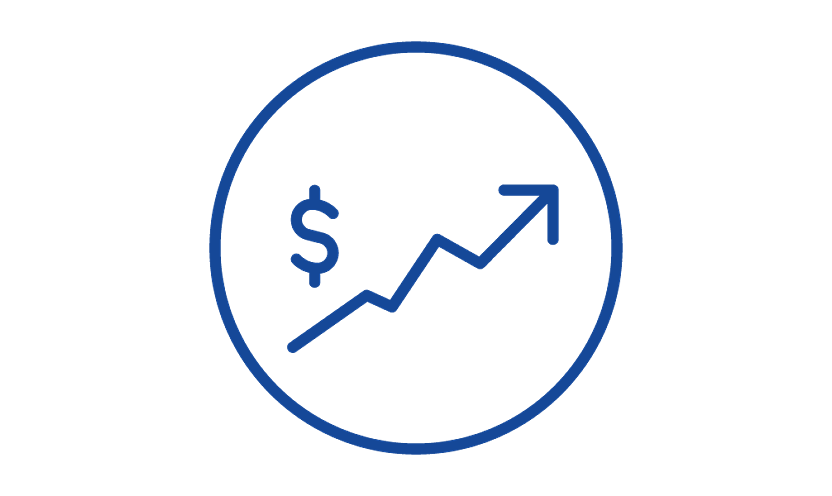





The Therapy2 surface is a standalone full air surface designed to manage your vulnerable patients, those on the ICU and stepdown environments.
With support for pulmonary therapy protocols, advanced skin protection therapy modes and more, the Therapy2 surface is specially equipped to help in the prevention of common complications associated with immobility.1-5
The Future of Support Surfaces
Watch the video to discover our THERAPY2 and SYNTHETO Surfaces.
More Than Just a Surface.
Meet an Air Surface Designed for Today’s Healthcare Organizations.
The Therapy2 therapeutic dynamic surface has integrated features to assist in prevention and treatment of pressure ulcers 3-7 and pulmonary complications associated with immobility 1-2, with pulmonary and skin features designed with vulnerable patients in mind. It’s an advanced hospital mattress ideally suited for Intensive Care (ICU) and Stepdown (SDU) Units.

Assist in Prevention and Treatment of Pressure Injuries3-7 and Pulmonary Complications Associated with Patient Immobility.1-2
The Therapy2 surface is designed to help you to:
- Laterally reposition the patient to reduce the interface pressure in the sacral area and increase turn engagement8,9 with turn reminders.
- Deliver programmable pulmonary therapies, including Continuous Lateral Rotation Therapy (CLRT) to assist in the prevention and treatment of pulmonary complications associated with patient immobility.1,2
- Easily implement patient prone positioning whilst patient is intubated10 to improve lung efficiency with the optional Prone Position Mode.
- Effectively remove excess heat and moisture away from patient’s skin at the interface between the patient’s body and the mattress with the Microclimate Management (MCM) system.11-14
- React to patients needs faster by having visibility at the nurse’s station or the EMR to a large set of patient and surface data sets (patient exit alerts, heart rate, respiratory rate, active time and remaining time of air therapy modes, etc.)15

The median prevalence of pressure ulcers in Europe is 10.8%16

The cost of pressure ulcer treatment per patient per day ranged from €1.71 to €470.4917

Patient Mobilization Mode
Help increase patient turn engagement and pressure ulcer relief with turn reminders, Continuous (CLP) and Alternating Low Pressure (ALP) modes.
* Optional Feature

Pulmonary Mode
Helps to prevent pulmonary complications using customizable side rotation cycles. It can be automated to assist the caregivers while respecting the protocols in force in the facility.

Prone Positioning*
Prone position management features helps caregivers to effectively manage patients in the prone position whilst patient is intubated.10

MICROCLIMATE MANAGEMENT Technology
The MCM technology is proven to effectively remove excess heat and moisture from patient’s skin at the interface between the patient’s body and the mattress.11-14

Mobilization Mode

Pressure Ulcer Mode

Pulmonary Mode

Prone Mode*

Continuous Monitoring**

Connectivity

The Therapy2 surface is designed to help you to:
- Implement skin protection therapies with Continuous Low Pressure (CLP), Alternating Low Pressure (ALP) and Pressure Ulcer modes and with the Microclimate Management (MCM) technology.
- The therapeutic and smart features help to release time for your busy staff, so they can streamline efficiencies and react to patient needs more quickly.
- Effectively manage patients that would benefit from the prone positioning10 with the optional Prone Position Mode.
- Enhance workflows with the integrated pump and X-ray sleeve. The integrated pump eliminates the need for the staff to find, install and clean the pump. And the X-ray cassette sleeve allows to perform in-room portable X-ray while the patient is lying on the surface.
- Stay connected to be informed on patient and surface status15 — so that your team can react to patient needs faster.

The healthcare workers shortage in Europe in 2013 was 1,6 million and the projection by 2030 is 4,1 million19

I-mmersion sensor
Controls and adjust in real-time cushion pressures according to patient size, shape, weight or position in the bed without caregiver intervention.

Contact-free, continuous monitoring**
The heart rate (HR) and respiratory rate (RR) are continuously measured while the patient is lying on the surface. It alerts caregivers of rates that exceed the pre-determined HR and RR thresholds.

Patient Exit Alerting
When the patient leaves the surface, the system alerts until the patient is back on the surface.

Stay Connected to Patient
Therapy2 sends to the nurse’s station or EMR clinical data, out-of-bed alerts, surface pressure notifications (PMAX) and other surface status data.15
*Optional feature
**Please check availability with your local Baxter representative
Healthcare Workers' Injuries
The prevalence of musculoskeletal disorders of workers in human health and social work activities in Europe is:
?$3X2W1712$&fmt=png-alpha)
experienced back pain
?$3X2W1712$&fmt=png-alpha)
experienced upper limb pain.20
What if we told you
That with Therapy2 you can achieve up to
?$3X2W1712$&fmt=png-alpha)
reduction in effort required to turn a patient with mobilization mode.18

THERAPY2 Surface Perfectly Fit Our HR900 Platforms:

CENTURIS PRO Bed

HR900 Bed

HR900 ACCELLA Bed
Contact us to verify the compatibility of Therapy2 with your existing beds.
Therapeutic Surfaces Collection from Baxter
Find the best hospital mattresses/surface within our portfolio to address your needs.
Because the proper care begins with the proper surface, for your patients and for your team.
Explore the Baxter Therapeutic Surfaces Portfolio
This site is intended for Healthcare Professionals.
Manufacturer: Hill-Rom S.A.S. - Z.I. du Talhouët 56330 Pluvigner, France
Class IIa - Notified Body GMED 0459
This medical device is a regulated health product which, pursuant to such regulation bears a CE mark. Baxter recommends that you carefully read the detailed instructions for safe and proper use included in the documents accompanying the medical device. The personnel of healthcare establishments are responsible for the proper use and maintenance of these medical devices.
References:
1. Swadener-Culpepper, Leslie et al. “The impact of continuous lateral rotation therapy in overall clinical and financial outcomes of critically ill patients.” Critical care nursing quarterly vol. 31,3 (2008): 270-9.
2. Goldhill, David R et al. “Rotational bed therapy to prevent and treat respiratory complications: a review and meta-analysis.” American journal of critical care: an official publication, American Association of Critical-Care Nurses vol. 16,1 (2007): 50-61.
3. Demarré, Liesbet et al. “The effectiveness of three types of alternating pressure air mattresses in the prevention of pressure ulcers in Belgian hospitals.” Research in nursing & health vol. 36,5 (2013): 439-52.
4. Manzano, Francisco et al. “Comparison of alternating pressure mattresses and overlays for prevention of pressure ulcers in ventilated intensive care patients: a quasi-experimental study.” Journal of advanced nursing vol. 69,9 (2013): 2099-106.
5. Cavicchioli, A, and G Carella. “Clinical effectiveness of a low-tech versus high-tech pressure-redistributing mattress.” Journal of wound care vol. 16,7 (2007): 285-9.
6. Shi, Chunhu et al. “Beds, overlays and mattresses for treating pressure ulcers.” The Cochrane database of systematic reviews vol. 5,5 CD013624. 10 May. 2021.
7. McNichol, Laurie et al. “Identifying the right surface for the right patient at the right time: generation and content validation of an algorithm for support surface selection.” Journal of wound, ostomy, and continence nursing: official publication of The Wound, Ostomy and Continence Nurses Society vol. 42,1 (2015): 19-37.
8. Schutt, Suann Cirigliano et al. “Pilot study: Assessing the effect of continual position monitoring technology on compliance with patient turning protocols.” Nursing open vol. 5,1 21-28. 26 Oct. 2017.
9. Internal Hillrom Summative Usability Test Report, PRJ01060 ISE, NPD45119.
10. Baxter Internal Testing; data on file NPD45119, NPD39210 rev.02 section 3.3
11. Denzinger, Markus et al. “A quantitative study of transepidermal water loss (TEWL) on conventional and microclimate management capable mattresses and hospital beds.” Journal of tissue viability vol. 28,4 (2019): 194-199.
12. Lachenbruch, Charlie et al. “Relative contributions of interface pressure, shear stress, and temperature on ischemic-induced, skin-reactive hyperemia in healthy volunteers: a repeated measures laboratory study.” Ostomy/wound management vol. 61,2 (2015): 16-25.
13. Lachenbruch, C. A laboratory study comparing skin temperature and fluid loss on air-fluidized therapy, low-air-loss, and foam support surfaces. Ostomy Wound Manage 56, 52–60 (2010).
14. Worsley PR, Bader DL. A modified evaluation of spacer fabric and airflow technologies for controlling the microclimate at the loaded support interface. Textile Research Journal. 2018;89(11):2154-2162.
15. Therapy2 Instructions for Use (217151EN) - Therapy2 uses the Wi-Fi connection to send data from the mattress to the hospital network for remote display. It allows the caregiver to have remote access to the mattress power supply information, Wi-Fi status, type of mattress, location of the device, presence of the patient on the mattress, patient identity validated or not, status of the CPR mode, current mode (CLT or ALT), status of the Microclimate Mode mode, patient exit alerts, status of the Mobilization mode, status of the Pressure ulcer mode, heart rate (HR) and respiratory rate (RR) and threshold alerts.
16. Moore, Zena et al. “The prevalence of pressure ulcers in Europe, what does the European data tell us: a systematic review.” Journal of wound care vol. 28,11 (2019): 710-719.
17. Demarré, Liesbet et al. “The cost of prevention and treatment of pressure ulcers: A systematic review.” International journal of nursing studies vol. 52,11 (2015): 1754-74.
18. Wiggermann, Neal. “Biomechanical Evaluation of a Bed Feature to Assist in Turning and Laterally Repositioning Patients.” Human factors vol. 58,5 (2016): 748-57.
19. Zapata, T., Azzopardi Muscat, N., Falkenbach, M., & Wismar, M. (2023). From great attrition to great attraction: Countering the great resignation of health and care workers. Eurohealth - Journal of the European Observatory on Health Systems and Policies, 29(1), 6-10.
20. European Agency for Safety and Health at Work. Discussion Paper: Musculoskeletal Disorders in the Healthcare Sector. European Agency for Safety and Health at Work, 2023.
EMA-CS394-240011 (v2.0) 04/2025






